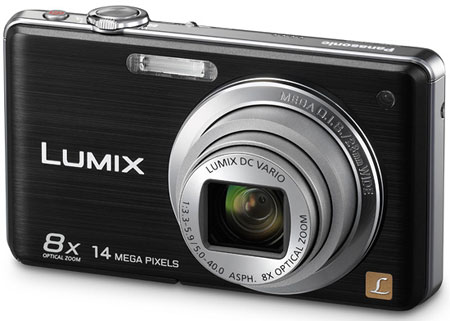Panasonic Lumix DMC-FS30 / FH20
-
-
Written by Gordon Laing
Verdict
The Panasonic Lumix FS30 / FH20 is an affordable compact super-zoom camera with an 8x optical range, 14 Megapixel sensor and 2.7 inch screen.
It can shoot 720p HD video and has plenty of automatic features like face detection AF and scene recognition making it a good choice if you’re looking for a capable super-zoom without the added cost and complication that more advanced models bring with them.
The FS30 / FH20’s good low light performance, combined with a long (8 seconds) maximum shutter speed and even longer exposures possible in some scene modes make it ideal for tripod-based night shooting, and when you don’t have a tripod handy its optical image stabilization is very effective.
 |
Compared to Fujifilm FinePix JZ300
Making a choice between the Fujifilm FinePix JZ300 and Panasonic Lumix DMC-FS30 / FH20 is more difficult than we thought it would be. They’re similar in weight and dimensions, though not in looks – the JZ300 is more robust and professional looking and we think the FS / FH range styling is beginning to look a little tired. In terms of handling, the Lumix FS30 / FH20’s screen was easier to get on with, making the whole experience of using the camera, particularly outdoors, more comfortable. The FS30 / FH20’s Q Menu, which provides fast access to commonly-used settings, was also an advantage.
Most obviously, the FS30 / FH20’s zoom range falls short of the JZ300 (280mm equivalent on the JZ300 compared with 224mm on the FS30 / FH20). That’s a significant differrence in telephoto reach, but against it the Panasonic Lumix FS30 / FH20 has an extra 2 milion pixels on its 14 Megapixel sensor. That would allow you to crop a Lumix FS30 / FH20 full resolution image down to the 4000 x 3000 pixel maximum resolution of the JZ300 and get a slightly closer result.
What about image quality? Again, there’s very little in it. In terms of overal image quality we can’t see enough of a difference between these two cameras to justify making a purchasing decision in favour of one or the other on quality grounds, though the Lumix FS30 / FH20 did better in our high ISO noise tests.
If you’re looking for something to separate these two cameras it’s going to come down to one of two things, handling and secondary features. The former is going to be a personal decision and, as always, we’d recommend you get a hands on experience of both models before making a decision. In terms of features it’ll be a question of how important things like video zoom, screen performance, Autofocus modes, and long exposures modes are to you. Who knows, in the end it may even come down to factors like whether an A/V cable is incuded in the box (Panasonic yes, Fujifilm no).
See our Fujifilm FinePix JZ300 review for more details.
Panasonic Lumix FS30 / FH20 final verdict
A 14 megapixel sensor, 8x optical zoom and HD video recording capabilities are features that you’d normally expect to have to dig deep into your pocket for, so there’s no question the Panasonic Lumix FS30 / FH20 represents excellent value for money.
By now, you’ll know that we’re not big fans of the FS / FH series styling, but that said, the FS30 / FH20 is a great camera to use. In auto modes it’s quick to focus, it’s scene recognition is quick and accurate and having a button that you can press to quickly enter Intelligent Auto mode means you really need never miss a shot. For more advanced shooting its Normal Picture mode provides manual ISO setting and it’s well-equipped for tripod-based shooting with an 8 second slowest shutter speed backed up by night scene modes for even longer exposures. Compacts with long telephotos need good optical image stabilization and the FS30 / FH20’s OIS system doesn’t disappoint.
That the FS30 / FH20 doesn’t have any form of zoom that you can use during video shooting doesn’t concern us overly. We’ve seen from the Fujifilm FinePix JZ300 that being able to use the zoom during shooting brings its own problems. We do, however, think that Panasonic need to take a look at their menu architecture. The design looks clumsy, the architecture is poorly thought through and, were it not for the presence of the Q Menu system, this would be a real hindrance.
The FS30 / FH20’s flash performance was also disappointing (though no worse than that of the FinePix JZ300). The way in which flash performance is specified using auto ISO settings is confusing, misleading even, and we’d urge all manufacturers to adopt a more meaningful system using a fixed ISO sensitivity.
As with the Fujifilm FinePix JZ300 though, these complaints don’t take too much away from a compact super-zoom that remains excellent value for money providing headline features that on many other models would cost you far more.
Bad points | Scores (relative to 2010 compacts) |
 | ||
Build quality: Image quality: Handling: Specification: Value:
Overall: |
17 / 20 16 / 20 16 / 20 17 / 20 17 / 20
83% | |||





